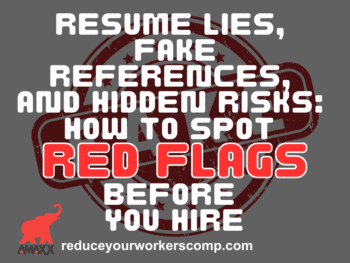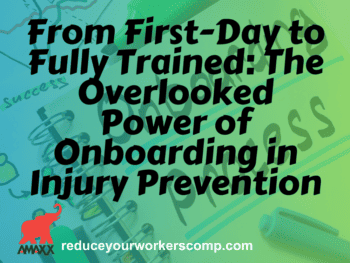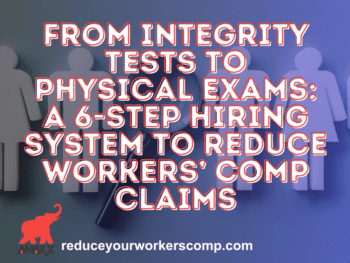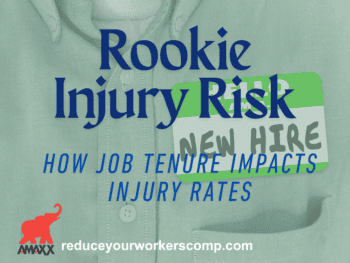
Hiring new employees can have risks, as they are typically associated with higher frequencies of workplace injuries. And some job candidates may be desperate for any kind of work and will exaggerate their abilities in order to get a job. The last thing an employer wants to do is hire their next workers’ compensation claim. In the current environment, where money is tight and every organization’s future is somewhat in doubt, it is more important than ever to ensure those employees who are hired are the most physically and mentally capable of handling the jobs.
Click Link to Access Free PDF Download
“4-Step Sequence For Effective Employee Screening, Hiring, & Placement”
Steps to Optimal Hiring
Experts identify several steps to weed out bad hires and identify those most likely to be successful.
-
Integrity Testing
Substance abuse, dishonesty, theft and hostility are not characteristics of ideal job candidates. Integrity testing can actually reveal those people who are less than optimal.
This pre-claim risk management tool is designed to find candidates with skewed value systems. People are presented with certain hypothetical situations and asked how they would, or have behaved in the past. An example of a question would be, ‘How often have you stolen from a previous employer because you felt underpaid?’
While it seems reasonable that such people would just lie on these tests, research shows they do not. They answer questions honestly about their counter-productive behaviors because they rationalize them as being acceptable.
On average, 25 percent of job candidates will fail integrity testing. Many seem wonderful — until you discover their willingness to engage in behaviors that could seriously hurt your business. Statistics also show that those who do pass integrity tests are more likely to also pass drug tests, compared to those who fail. People with poor value systems tend to make poor judgement calls in their lives.
-
Interview and Conditional Offer
Following the integrity testing, employers interview the remaining candidates to determine who is the best fit, and then makes a conditional offer of employment.
It may go something like, ‘We are pleased to make you an offer conditioned on your ability to physically and mentally perform substantially all the essential duties of the position.’ This opens the door for the employer to conduct testing that is related to, and consistent with business necessity.
-
Post offer Screening
A variety of tests and searches may be undertaken to ensure the candidate is, indeed, a good fit for the position. Included may be:
- Drug testing
- Background screening, such as
- Criminal records
- Driving records
- Credit reports
- Social Security number verification.
- Comprehensive medical history and baseline medical measures to identify pre-existing conditions that may need medical clearance or prove the individual is safe to perform their job functions
- Job-specific functional testing to ensure the person can complete the residual and essential functions of the job
Functional job testing requires the employer to identify essential versus non-essential and residual functions to properly match workers to required job demands and make accommodation considerations when needed. There are commercial validation systems for essential function identification in compliance with federal requirements. But simply stated, the employer and their workers need to identify why the job exists and what is physically necessary to accomplish the primary functions.
“The easiest way to validate the essential functions is to have incumbent workers go through the descriptions and confirm it is what they actually do,” explained Larry Feeler, CEO, and Founder of WorkSTEPS. “Then qualifying strength requirements and mock testing of the essential functions are agreed upon to screen prospective workers to ensure their safety.”
Such tests can be quite extensive, and are designed to also measure job-specific stamina, mobility, flexibility, cardiovascular condition, hand strength, and dexterity.
“All sports participants have prescreening physicals”, states Feeler “and it makes sense to prescreen workers according to the Americans with Disabilities (ADA) guidelines to avoid unnecessary injuries by clearing their pre-existing conditions and having them actually demonstrate their safe ability to perform the essential functions.”
The candidate needs to be able to perform all the essential functions of the job, whether with or without an accommodation. Candidates who perform the essential functions are hired. Candidates with a pre-existing medical impairment may be required to get medical clearance prior to testing and after testing, if a medical risk affects their essential function performance. Candidates who can’t complete the essential functions are not hired or may be matched to a less physically demanding job that matches their ability. A “qualified individual with a disability” can request a reasonable accommodation that requires an interactive process to determine if such a request creates an undue hardship for the company. According to Feeler, “we have tested millions of workers with less than 1% requesting an accommodation consideration. We find that disabled individuals typically apply for a job they know they can perform and are very motivated.”
Under the Americans with Disabilities Act, employers must make reasonable accommodations for a person with a disability if that allows him to fully perform all the essential functions of a job. Employers are not obligated to hire candidates who cannot perform all the essential functions of the job even with accommodations.
A significant benefit of the post-offer test is to establish the person’s baseline physical condition. If a person does become injured on the job but had a preexisting condition, the employer/payer is on the hook only for the difference caused by the new injury. Without knowing a person’s baseline, the employer/payer would own the entire injury.
-
Hire the Candidate!
Conclusion
It’s impossible to guarantee that someone hired for a particular position will always be free of injuries and illnesses. However, companies who perform such tests, consistently lower their worker’s compensation claims by over 50% the first year for employers large and small! Apparently, doing the proper legwork beforehand offers the best chance of success.

Contact: mstack@reduceyourworkerscomp.com.
Workers’ Comp Roundup Blog: https://blog.reduceyourworkerscomp.com/
©2020 Amaxx LLC. All rights reserved under International Copyright Law.
Do not use this information without independent verification. All state laws vary. You should consult with your insurance broker, attorney, or qualified professional.

















